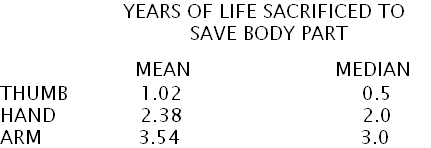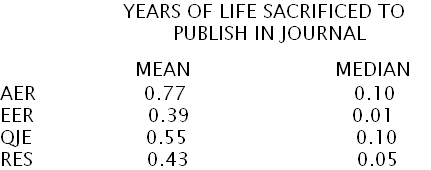The average economist would sacrifice 1.02 years of life to avoid losing a thumb, or .77 years of life to get a paper published in the American Economic Review. An AER publication, then, is worth about 3/4 of a thumb.
We learn this from a study by three economists who sent out 1300 questionnaires, all to economists who had recently published in one of six major journals. They received 85 responses. Of these, 7 were discarded because they claimed to value their thumbs more than their entire hands, or their hands more than their entire arms, and another four were discarded because they indicated they were willing to sacrifice life-years for the privilege of losing a body part. The remaining 74 respondents valued their body parts as follows:

The economists were then asked how many years of life they’d sacrifice to get an article published in each of four major journals: The American Economic Review, the European Economic Review, the Quarterly Journal of Economics, and the Review of Economics and Statistics. Thirteen respondents were disqualified for refusing on moral grounds to achieve publication by extraordinary means and another three were discqualified for indicating that they’d sacrifice life-years to avoid getting an extra publication. The remaining 69 respondents valued publications as follows:

To get the value of a publication in terms of body parts, the authors divide the means, so that for example an AER publication is worth .77 years, a thumb is worh 1.02 years, and therefore an AER publication is worth, on average, .77/1.02 thumbs.
Clearly, though, this can’t be exactly the right procedure. Suppose that half of all economists would sacrifice one year for a thumb and three years for a publication, while the other half would sacrifice three years for a thumb and one for a publication. Then the average value of a publication is the average of (1/3 thumb) and (3 thumbs), which is to say 5/3 of a thumb. But the authors’ procedure will tell you (incorrectly) that because the average economist values a thumb at 2 years and a publication at 2 years, the average publication is worth 1 thumb. Perhaps this is why their paper has not been published in the AER.
For what life goal would you be willing to sacrifice a thumb, but not a hand?



For what life goal would you be willing to sacrifice a thumb, but not a hand?
The life goal of going through life with two hands and at least 9 fingers.
NB : I think the 6% response rate indicates another problem with their methodology.
For the publications there is a huge difference between mean and median. This surely indicates that any statistics based on “normal” distribution will be a bit suspect.
Why do this with years of life rather than $$$?
Forgive me for going off topic a little but my main take away from this is that if surveys of high IQ economists result in so many wacky responses, how can we trust any surveys? Every few weeks there is a news story about some survey that gets people up in arms because 10% of respondents have some crazy notion.
The subjects had recently published in these journals, and therefore satisfied the urge to do so and extracted the rewards in terms of reputation etc. The need to publish again would be much reduced. They also have proved that they can get published without sacrificing any body part. How much more would such publications be worth to those aspirant economists who have not yet published?
The money connection is a good one. How does the year-of-life unit stack up against compensation, and does this tie in in any way to value of life calculations? For example, compensation schedules show a thumb to be paid at 75 weeks, a hand at 244 weeks and an arm at 312 weeks pay. In terms of thumbs, a hand is worth 3.2 thumbs and an arm = 4.2 thunbs.
the economists valued a hand at 2.4 and an arm at 3.5 thumbs, which is not too dis-similar.
The ecomnomists valued a thumb at 1 year of life, which is worth 75 weeks pay according to the schedules. Does this sound reasonable?
Aveage income is $81K, so one year would be worth $116K. Does this relate to other data in a meaningful way?
I see they did ask willingness to pay for the same. AER publication was valued at $12,600, which they valued at 0.77 years of life, or 16K for a year. If we correlate this with a thumb valued at 1 year, then an economists thumb is worth only $16K, compared to a worker’s thumb of $116K.
I’d give my right arm to be ambidextrous.
How much would they give not to be from Wuhan?
For what life goal would you be willing to sacrifice a thumb, but not a hand?
The ability to regenerate lost body parts.
With serious economists giving these wacky responces (more for a thumb than a hand etc). I’m wondering how much trolling went on when filling these things out.
I was thinking along similar lines. If I were given this questionnaire, I’d offer the observation that I value my thumbs highly — but I’m more than willing to give them the finger.
I have just seen that my comparison of economists’ and workers’ thumbs is comparing willingness to pay and willingness to accept.
Nobody.really wins the thread.
Even though it was just a throwaway line …
You’re too modest, Ken B. Your Wuhan comment was hilarious.
@CC: Thanks. But shhhh! Don’t tell Bob Murphy!!
Ironically, many of those authors probably already gave up more than 0.77 years of their lives to publish.
I’ve given up more of my life on some papers than I care to admit.
Don’t the numbers of years sacrificed seem awfully low across the board? E.g. I’d rather be able to play golf (badly) for as long as I can, than have a couple extra years of sipping my pureed lunch thru a straw held in my non-preferred hand. Makes me wonder if these are economists who endorse a free market in body parts.
I also have to wonder at any economist who doesn’t get the ‘game’ that everything can be expressed in terms of anything else, but rather raises moral objections to the formulation.
If a thumb is worth $115K, then, at a 5% interest rate, possessors of thumbs gain a benefit of $5,750 per annum. Should we tax them on that? Or, at least, give non-thumb-possessors a tax rebate of $5,750?
If not, why not?
How much would you pay? How many thumbs would you give up? How many years of life would you give up?
… to be born in the USA or to be born in some random country? (1/6 chance in China, 1/8 chance in India, etc.)
Fantasy questions are always fun, but usually without too much meaning. First, “giving up one year of life” is a virtual if not literal existential impossibility. Tell me when you “would have died” then I can take away that year. Since you cannot do that, it is a meaningless concession.
Perhaps one could say to one of these guys “hey, I am definitely going to kill you a year from now—-but I will do you a favor. I will publish your essay and kill you right now”. Who will take that deal? Everyone always assumes that “extra year” is 40 years from today.
Thumbs are perhaps more easily tested. Too bad we cannot sell thumbs or have them transplanted. Then we can test that as well. I am pretty sure those answers would change.
awesome.if only i could do research by mailing questionnaires.
empirical investigation would include the views of economists who have ALREADY sacrificed their thumbs .demonstrated preference trumps fantasies,everytime
WHICH years of life are we talking about here?
I’d give up a year at life’s end (e.g. 99-100) much more willingly than one at, say, 40-41.
“Then the average value of a publication is the average of (1/3 thumb) and (3 thumbs), which is to say 5/3 of a thumb.”
Yes but the average value of a thumb would b e 5/3 of a publication, so where would that leave you?
Does it have to be my thumb? I can think of four, maybe five thumbs I’d happily give up to NOT be published in the AER, if-you-know-what-I-mean. ~.^
My vote is for Pat T winning the thread.
Most economists have three hands to begin with. Therefore, giving up one hand might not be so bad except that they would then have to change occupations to something based on reality.
http://en.wikipedia.org/wiki/Ekalavya